THERE IS UNDERGRADUATE STUDENTS OFFICER? 1,056 HOW SAFE CAN OU POLICE KEEP CAMPUS Q Crimson QUARTERLY WINTER 2022 | OUDAILY.COM WHEN FOR EVERY 1



OU DAILY KNOW SOONER Download the OU Daily app Get notifications. Get news tailored to you.
MISSION
Crimson Quarterly, the OU Daily’s news magazine, covers community issues and personalities in depth and provides a public forum to discuss its issues while providing students on our staff real-world media experiences.
MASTHEAD
JILLIAN TAYLOR
ALEXIA ASTON MASON YOUNG SILAS BALES RAY BAHNER FRANCISCO GUTIERREZ CONNIE WIGGINS SETH PRINCE
Editor-in-chief News managing editor
Sports editor Culture editor Photo editor Copy chief Design editor Newsroom adviser
CONTACT US
160 Copeland Hall, 860 Van Vleet Oval, Norman, OK 73019
NEWSROOM: 405-325-3666 | dailynews@ou.edu
ADVERTISING: 405-325-2521 | dailyads@ou.edu
OPINIONS & SUBMISSIONS
Letters to the editor or guest columns may be submitted to dailyeditor@ou.edu. They will be edited for accuracy, space and style and run at the discretion of the editor-in-chief. Students must list their major and classification; faculty or staff must list their title. Our views are the view of the Editorial Board. Opinions are not necessarily those of the Editorial Board.
LEGAL
One free copy is available to members of the community. Extra copies may be purchased. Thefts are subject to legal action. Crimson Quarterly is a publication of OU Student Media. It is printed at no cost to Oklahoma taxpayers.
CORRECTIONS
OU Daily is committed to accuracy. If you find an error in our work, submit a correction at oudaily.com/corrections.
FIND US ONLINE
oudaily.com oudaily.com/newsletters oudaily.com/archive oudaily.com/jobs oudaily.com/donate oudaily ousoonerscentral @oudaily @oudailysports @theoudaily
OUPD STAFF RETENTION CRISIS
OVERCOMING GENDERED PERCEPTIONS IN ESPORTS
EDUCATORS’ FRAUGHT FUTURES
SONIYES REVITALIZES 15-YEAR LEGACY
SECTION 8’S BROKEN SYSTEM
3
4 8 12
17 21
INSIDE
HOME PAGE NEWSLETTERS PRINT ARCHIVES JOIN US DONATE FACEBOOK SPORTS FACEBOOK TWITTER SPORTS TWITTER INSTAGRAM Q Crimson QUARTERLY
OUPD staff retention crisis
September.
That means for every 1,056 undergraduate students, there is one officer.
JAZZ WOLFE jazzwolfe@ou.edu
Unused patrol cars parked outside, empty cu bicles in dark rooms and piles of paperwork on cluttered desks are just some of the visual symp toms of the OU Police Department’s struggle to retain its officers.
Since 2017, the department’s staff has de clined amid a lack of competitive pay as the university continues to grow its student popula tion. The issue has left OU less prepared to en sure community safety from thefts, assaults and shootings across campus, according to an OUPD employee, who the Daily granted anonymity to ensure their job security.
Nathaniel Tarver, the OU Police Department chief and associate vice president, said only 27 of 40 allocated positions at the OU-Norman campus police department were filled as of

Compared to some Big 12 schools, only OU has a ratio of more than 1,000 students per offi cer. However, among the 10 schools in the con ference, only six campus police departments list employment numbers online. OU is not one of them.
Oklahoma State University is the closest, with a ratio of 705 students per officer. The smallest ratio is at Texas Christian University — a private research institution — with 190 undergraduate students per officer.
The University of Kansas has the most similar undergraduate student population to OU with 27,685 undergraduate students — compared to OU’s 28,502 — among the six Big 12 universities with publicly available data. Its student-to-officer ratio is 486 students per officer, meaning OU’s ratio is over 100 percent higher.
The department has also consistently lost offi cers in recent years. According to the OUPD em ployee, 35 officers have left the department since 2017, and the department’s total retention rate since 2017 is around 55.5 percent. Of the 22 offi cers it has hired in the past five years, 16 have left.
Despite a decline in officers, enrollment
numbers have steadily increased since 2017. OU has repeatedly broken university records for the largest freshman class in 2017, 2019, 2020, 2021 and 2022.
Tarver said part of the challenge of employ ing officers is not having a competitive pay rate.
OU offers a starting salary of $51,563, according to OUPD’s website. In comparison, the Norman Police Department offers $55,923 with raises every six months, and the Oklahoma City Police Department offers $60,427 for officers with a $5,500 signing bonus, according to each depart ment’s website.
Additionally, recruiting officers is a slow pro cess, Tarver said. It takes around a year for offi cers to complete courses at the police academy and training on campus protocols and culture.
“(People) look at campus policing and they think it is something less than a municipal po lice officer or state police officer, and it’s just not,” Tarver said. “The duties, the skills, the training that we do is on par with all those agencies.”
OUPD can recruit only two to three new of ficers at a time, Tarver said. It would take about four to six years for the department to fill all of its empty positions, assuming no officers leave during the process.
OU President Joseph Harroz Jr. told the Daily
4
As the student population swells, struggles to recruit, maintain officer positions threaten campus safety
JACKSON STEWART/OU DAILY
OUPD officers walking up to the Oklahoma Memorial Union with their rifles drawn. Less competitive pay and a slow recruitment process have left OU with fewer officers.
in September he had conversations with Tarver about potential solutions for OUPD’s understaff ing and low pay.
Harroz’s solution was to reallocate around $491,000 to the OU-Norman campus and Health Sciences Center police departments. The fund ing is temporarily coming from the salaries of the open positions, Tarver said.
“I asked the question point-blank of the po lice chief: ‘Is this what you need?’” Harroz said in September. “And he said, ‘Yes.’”
Harroz said he was also looking into future solutions.
Tarver confirmed the university is exploring op tions for additional funding, but he said this meth od will only be sustainable for a few years if the de partment can’t quickly fill the open positions. He said he hopes this method will help retain current officers while recruiting more.
“The positions we have right now that are empty, that’s basically what we’re using to fold into (the budget),” Tarver said. “(We will) canni balize those to raise salaries of the existing people here now.”
There are multiple methods to determine the best student-to-officer ratio on a campus, accord ing to the International Association of Campus Law Enforcement Administrators.

One of the more common methods among campus and municipal police departments is the minimum-staffing model, in which police leader ship chooses a minimum number of officers to be on each patrol.

However, there is no standard ratio suggested among campus police departments, according to the organization’s website.
OUPD doesn’t disclose why there are 40 allo cated positions on its website. However, Tarver said the university has set a minimum number of officers per patrol shift, a policy similar to the min imum-staffing model.
Tarver said he would like more officers pa trolling the 5.2-square-mile campus. He said it isn’t safe to disclose the exact number they have patrolling at a time but that he would ideally dou ble the minimum number.
Overworking officers because of low staffing is another concern, Tarver said. Daily events and in cidents on campus require OUPD’s presence, he said, which keeps them spread thin and prevents them from taking time off.
During the week of Oct. 3-9, there were 958 in cidents involving officers, according to OUPD re port logs. A majority of the incidents were labeled as patrol.
Additional reports included welfare checks, safety escorts, medical assistance and thefts. There was an average of 137 incidents per day, and other weeks show similar numbers.
Serious and violent crimes like domestic vio lence and burglary on campus happen regularly, according to OU’s 2022-23 Annual Security and Fire Safety Report. The report showed an increase in domestic violence and motor vehicle thefts on and around campus in 2021. It also included over 100 drug- or alcohol-related arrests and several hundred disciplinary referrals each year.
Tarver said the small staff and heavy caseload
5
JAZZ WOLFE/OU DAILY
AS OF SEPTEMBER 2022
JAZZ WOLFE/OU DAILY
also doesn’t provide enough time for refresher training — a standard practice in law enforcement — because most officers are preoccupied during their shifts.
OUPD’s officers conduct regular active shooter trainings within the department and offer simi lar sessions to those on campus who request it. Tarver said the department has seen a sharp in crease in training requests in the past six months because of the national attention mass shootings have received this year.
Shootings — particularly mass shootings — have been on the rise in the past decades. In 2016, a report from the Citizens Crime Commission of New York City showed there had been a 153 per cent increase in shooting events from 2011-16 compared to 2001-6. The events also had a 241 percent increase in casualties.
On May 24, 21 people were killed in a shooting in Uvalde, Texas. About a week later, five people died in a shooting at the Saint Francis Hospital in Tulsa. On Oct. 5, a professor was shot and killed in his office at the University of Arizona by a former student.
Data from The Violence Project, a nonprofit re search center, shows instances of mass shootings were steadily increasing until 2020, when there was a sharp decrease around the same time the COVID-19 pandemic began. In 2021, instances of mass shootings rapidly returned to previous numbers.
A similar pattern remains in 2022. As of Sept. 5, there have been 464 mass shootings in the U.S. this year, an average of almost two shootings per day. When asked about the potential for an active
shooting on campus, Harroz said his son had re cently gone through active shooter training at his school. He said he was comforted, but also sad dened his son had to have the training, calling it a tragedy and a crisis.
“If you’re not planning for (an active shooter), you’re not being honest,” Harroz said.
Tarver said he is confident OUPD would keep campus safe in the event of an active shooter and that its partnership with the Norman Police Department would allow it to respond quickly, swiftly and proficiently to any threat.
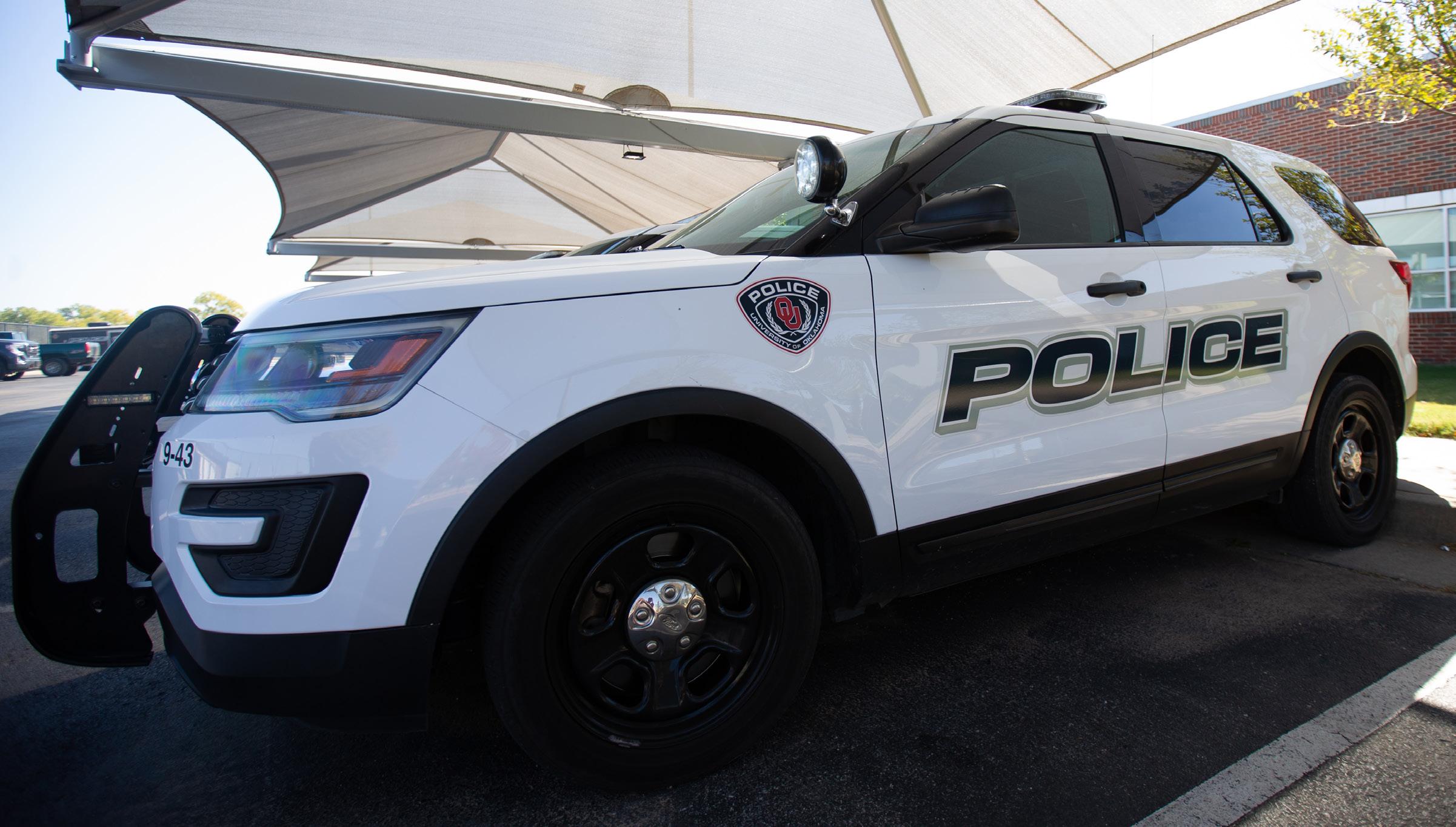
All active shooter events are different, however, and Tarver said it can be hard to plan for what the department would do in the worst-case scenario.
“I’m not sure anybody’s actually prepared for an active shooter,” Tarver said.
In 2019, Gallup Poll reported that nearly half of Americans fear they will be a victim in a mass shooting. That fear can be devastating to a per son’s physical and mental health, said Linda Barnum, an OU psychology professor.
If a person does not feel safe a majority of the time, it becomes difficult for people to recognize when they’re safe, and hypervigilance can make it nearly impossible to think, Barnum said.
She added that the constant state of adrenaline can weaken the immune system, making people more vulnerable to disease.
“Each generation has always had to face their version of what is safe and what is not,” Barnum said. “The generation before me had World War II. The generation before (this) maybe had Vietnam. Society, as always, had an interaction with vio lence. In our current culture in America, (this)
generation has this.”
Experiencing that level of hypervigilance exac erbates anxieties students experience on a college campus, Barnum said. Arriving in a new place with more freedom often leads people to neglect ing to certain physical needs, such as sleeping and eating well, she said.
Many students come into contact with alcohol, nicotine and marijuana for the first time in col lege, causing mental and emotional strains on the average student, Barnum said.
The consistent fear of dying from something uncontrollable can make it nearly impossible to function, Barnum said.
“The issue will always be at a human level,” Barnum said. “How do we maintain our own right to a felt sense of safety in a world that has never been safe?”
As issues across campus arise, Tarver said he wants everyone to feel assured that OUPD will respond.
Tarver said his main priority is to ensure the safety of students and faculty on campus with the staff he has, but he emphasized the importance of people being aware of their surroundings to keep themselves safe.
“I want everyone to know and feel safe enough to realize that yes, we will respond and we will address the issue,” Tarver said. “But the safety is sues that everybody needs to be concerned with fall within themselves, to be aware of the things that are around them and how (they) are going to react.”
RAY BAHNER/OU DAILY
6
Low staffing has led to remaining personnel being overworked, spreading them thin and offering them little time off.

Fees subject to change. Limited time only. See office for details. CALLAWAYHOUSENORMAN.COM Apply for Fall 2023 and save $100 with zero deposit! Now Leasing for Fall 2023
OVERCOMING PERCEPTIONS GENDERED IN ESPORTS
Despite online harassment and false stereotypes, women at OU fulfill passion for video games in collegiate competitions
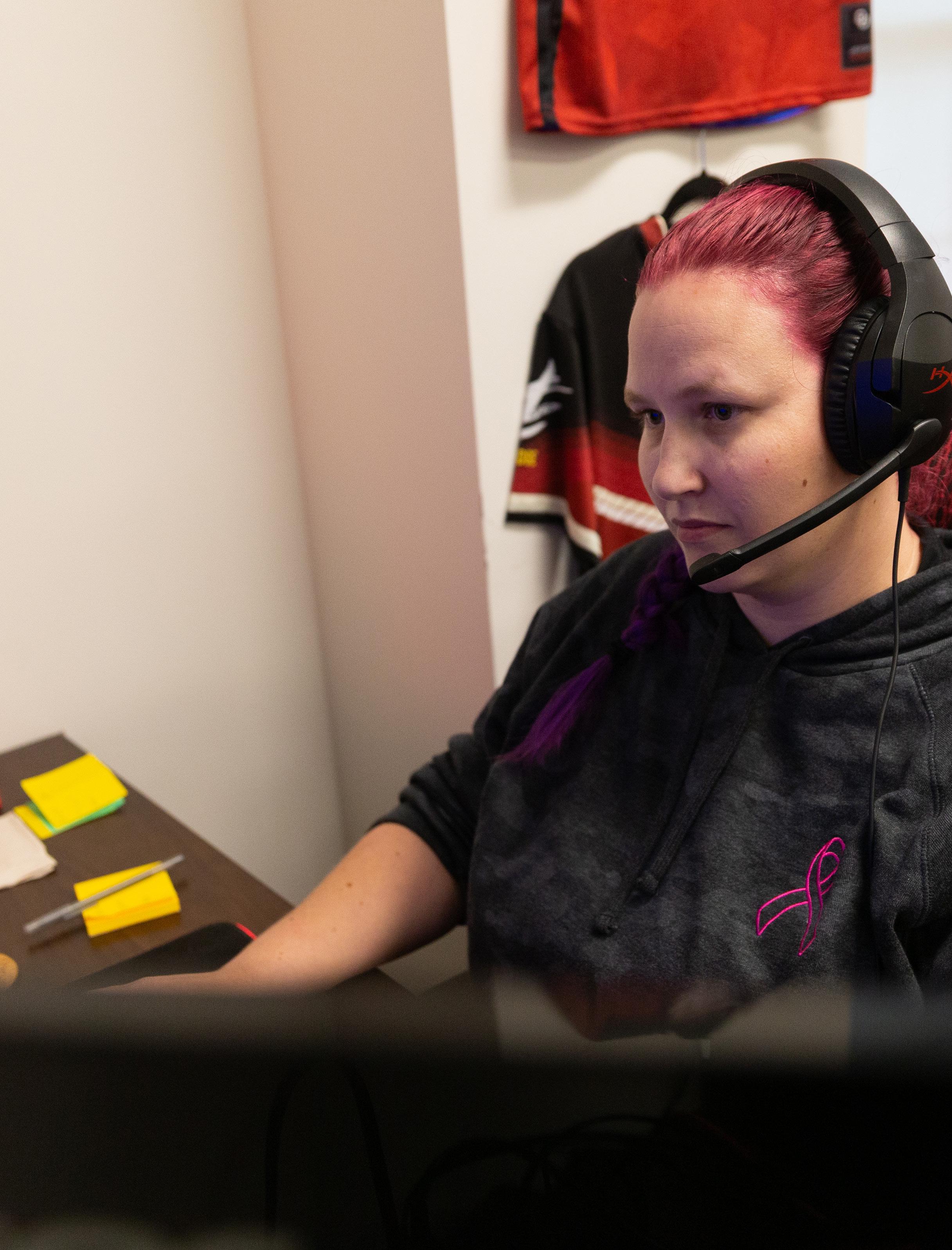
8
ALEXIA ASTON/ALEXIAASTON@OU.EDU
RAY BAHNER/OU DAILY
One of Jody Farmer’s most vivid memories growing up was playing “Sonic the Hedgehog” with her brother on his Sega Genesis. Her broth er taught her how to play so he wouldn’t have to play alone.
Since the 1980s, young girls almost always played video games on their brothers’ Nintendo Entertainment Systems, said Chris Bingham, an OU history of gaming professor, although the media didn’t always portray this reality.
He said girls who weren’t playing video games probably didn’t have a brother who owned a console, and parents typically weren’t buying Nintendos for their daughters.
Now, Farmer,assistant director of Intercollegiate Esports at OU and an art and tech nology junior, coaches a professional esports team in an all-women “Call of Duty” league, after creating OU’s first “Call of Duty” team.
Women like Farmer make up 45 percent of fe male gamers in the United States despite the belief that gaming is a male-dominated space.
‘Young
women are playing video games’
When video game consoles were first sold, it was more socially acceptable for a boy to own one than a girl, Bingham said. Technology was associ ated with a male interest, he said.
Children as young as 6 years old develop ideas that boys are more interested in computer science and engineering than girls, according to a study from the University of Houston and the University of Washington published in November 2021. Researchers found that 51 percent believe girls are less interested in the fields than boys.
“There was this assumption that, ‘Who’s going to grow up to program computers?’ It’s going to be the little boys, not the little girls, because of our gender assumptions about who goes out and works, who innovates, who invents, versus who doesn’t do that and takes care of the kids,” Bingham said.
But for Farmer, gender assumptions weren’t a concern, especially in her adulthood.
Before going to OU, Farmer served in the Navy in 1999 and transferred to the Army in 2005. During basic training, Farmer said the recruits were taught a team mentality. However, despite wearing the same uniform as everyone else, she faced gender-based harassment, especially after becoming pregnant.
“I literally had guys in my squadron who were
rude enough to ask me for milk for their coffee,” Farmer said. “When I was pregnant, they were tell ing me I’m getting pregnant on purpose to get out of doing my job.”
The harassment, Farmer said, contributed to her ability to overcome adversity and coach in competitive gaming.
In the military, Farmer ruptured her back, re quiring titanium to be inserted into her spine. During the height of the COVID-19 pandemic, Farmer found a community within a Discord server associated with the Wounded Warrior Project dedicated to gaming and allowing veter ans to connect online.
She played in different tournaments, including competitions based on her favorite “Call of Duty” game mode, “Search and Destroy.”
For Farmer, the opportunity to compete with other veterans via gaming improved her mental health, especially after her back injury.
“People see the injury first and not the person,” Farmer said. “In the virtual world, we don’t have that issue.”
Farmer said gaming allows her and other vet erans to be tactical by thinking on their feet, using strategic ideas, leading and teaching a squad, and improving in a given game mode.
At the time, Farmer met a gamer online who strategically broke down each map and tactics on “Search and Destroy.” This helped Farmer gain a better understanding of the game and become an effective coach.
When Farmer began attending OU in 2020, she brought her talents to OU Esports. Mike Aguilar, the director of OU Esports, discovered Farmer’s involvement in the Wounded Warrior Project and asked her to create and lead a “Call of Duty” team for OU Esports.
Four percent of collegiate esports coaches and 8.2 percent of collegiate esports players are women, according to a 2019 report.
The OU Esports “Call of Duty” team’s first tour nament in fall 2020 ended in a forfeit by one of their opponents because the team didn’t arrive on time, Farmer said. She said the forfeiting team found her and targeted her on social media and in her Twitch stream after the tournament.
“They (commented) all sorts of really hurtful things just because they thought it would get a rise out of me,” Farmer said. “They thought if they attacked the fact that I’m a female that it would make me have a certain reaction, and I wouldn’t give them that satisfaction.”
Farmer said OU Esports leadership backed her during the incident, which led to increased trust in the organization and respect from her team.
“That whole issue gave me the courage to keep going and keep fighting and make changes,” Farmer said. “It put some steel in my spine and made me want to continue going forward and change things and not necessarily let people con tinue how things have always been done.”
Fear of public matches and harassment
Kate Furney, OU Esports influencer develop ment director and creative media production junior, said her interest in gaming was formed in high school by the single-player, story-based
game “Mass Effect.”
Now, she plays games like “Overwatch,” “The Sims” and “Minecraft,” which she enjoys stream ing on Twitch.

“So far, (all my viewers) have been pretty nice. The first time I got a donation, I literally cried,” Furney said. “Somebody liked my content enough that they were willing to give me money.”
Her love for streaming is sometimes met with personal concerns for her safety as a woman, she said. Furney said she’s scared of viewers doxxing her just for being a woman.
When she plays in public matches on “Overwatch,” Furney said she typically avoids
using voice chat due to fear of gender-based ha rassment. Furney said she thinks she’d also be a better player if she could use voice chat because coordinating with her teammates would be easier.
Farmer said she avoids public matches entirely.
“They’ll literally try and chat with me and say the most derogatory things,” Farmer said. “Being behind a screen and controller gives you a right to just be an ugly person?”
In a recent study, 76 percent of female gamers said they disguise their gender when playing pub licly, and 93 percent of those said it was because they’ve previously experienced sexual harass ment online.
The perception that gaming is a male-centric sphere contributes to this harassment, Bingham said.
He said there are also people attempting to keep women out of gaming to maintain the notion that gaming is a masculine activity, which could explain online harassment. Certain people use online gaming to say things they’d typically face consequences for in real life, Bingham said.
Most video games offer resources to mute, block and report online gamers. The company that developed “Call of Duty” and “Overwatch,” Activision Blizzard, faced a lawsuit in 2021 by California’s Department of Fair Employment and Housing alleging the company fosters a “breed ing ground for harassment and discrimination against women.”
“People stand up and say, ‘It’s not okay,’” Farmer said. “Having people show their support, I think, is very important to see. (It’s important) people un derstand that women should have rights.”
Farmer and Furney are two of the three female
9
“
That whole issue gave me the courage to keep going and keep fighting and make changes.
SCHERER/OU DAILY
JODY FARMER, assistant director of Intercollegiate Sports at OU
“ BAYLOR
student leaders in OU Esports. The third, Kristine Nguyen, described finding a sense of belonging in OU Esports.
The biochemistry senior became the organiza tion’s marketing director in January and said she
As an adult, her interest in electronics translat ed into mostly casual games like “Minecraft,” but sometimes, she plays more competitive games like “Valorant.”

She joined OU Esports in January and remem bers feeling intimidated and shy but was quickly welcomed and accepted by the organization’s members.
“I was just … being a silly, little, goofy person,” Nguyen said. “I tried to act that way with all of the other competitive players. … Everyone should be not as serious.”
She said the time she spent with her father during her childhood helped her disregard the fact that she’s a woman in seemingly male-dom inated fields, especially as she pursues a career in orthopedics.
““I’ve been kind of bouncing back and forth be tween being pre-med and gaming,” Nguyen said. “I think both helped me develop a tougher skin when it comes to criticism because of my gender.”
Moving forward
in 2023.
She’s also looking forward to moderating es ports competitions in the Invictus Games in 2024, which is an Olympic-style competition for injured and sick servicepeople.
Furney said she’s always wanted to be a produc er, and with her involvement with esports, a career in that field doesn’t seem impossible.
Farmer said she hopes to inspire other female gamers to step out of their comfort zones.
“We need to make those mentors and make those people for these girls to look up to so there’s a good split in the competitive side between men and women,” Farmer said. “For now, that’s us pav ing our own way to show them that they can’t stop us.”

was always interested in technology. As a child, computers were frequently in her house due to her dad’s career as an engineer. She’d unplug all of the cords from a computer, then replug everything back in from memory.
Farmer isn’t sure what she wants to do after she earns her degree, but she envisions a career in volving veterans, gaming or both.
For now, she looks forward to her professional esports team, Team Effect, to begin competing
RAY BAHNER/OU DAILY
10
While pregnant, Jody Farmer, associate director of Intercollegiate Sports at OU, faced increased gender-based harassment from online competitors.
Being behind a screen and a controller give you a right to just be an ugly person?
BAYLOR SCHERER/OU DAILY
KATE FURNEY, OU Esports influencer development director
“

11 Lingerie • Sex Toys • Fetish • Pride Gear • Hosiery Visit us In-Store or Online at: www.romantix.com www.romantix.com come visit us. SCAN FOR LOCATION SCAN FOR LOCATION SCAN FOR LOCATION SCAN FOR LOCATION Lingerie • Sex Toys • Fetish • Pride Gear • Hosiery Visit us In-Store or Online at: www.romantix.com SCAN FOR LOCATION SCAN FOR LOCATION SCAN FOR LOCATION SCAN FOR LOCATIONNEW NORMAN STORE! 1915 Classen Blvd. Norman, OK 73071 (405) 529-1889 OKC LOCATIONS: 3000 SW 89th St. | 4005 / 4007 N. Pennsylvania Ave. | 16600 N. May Ave.
Educators’ fraught futures
studies education at the OU Jeannine Rainbolt College of Education. Now, as a senior, she serves as the president of the Oklahoma Aspiring Educators Association, or OAEA, in connection with the Oklahoma Education Association.
 KAROLINE LEONARD karolineleonard@ou.edu
KAROLINE LEONARD karolineleonard@ou.edu
Jacie Doyle-Lackey abandoned her plans for law school and transferred from Oklahoma City University to OU in the hopes of becoming a teacher. She was inspired by her parents’ teach ing careers in Oklahoma.
“They told me my whole life, ‘Don’t be a teach er,’” Doyle-Lackey said. “But I couldn’t help it. That’s where my heart is.”
Doyle-Lackey decided to focus on social
Doyle-Lackey said, although her passion for education continues, she has come to learn the many faults of the Oklahoma public school sys tem through her involvement. She said this year’s midterm elections are more crucial than ever in terms of Oklahoma education.
Joy Hofmeister, Oklahoma’s superintendent of public instruction and the Democratic guberna torial candidate, switched her political party in October 2021 to run against Republican incum bent Gov. Kevin Stitt in response to his actions and beliefs surrounding public education, like his lack of efforts to increase teacher pay and his goal to eradicate certain race and gender conver sations from schools.
Ryan Walters, a Republican, and Jena Nelson, a Democrat, now vie to become Oklahoma’s next state superintendent. Nelson was the 2020 Teacher of the Year and teaches English com position at Classen School of Advanced Studies Middle School, and Walters is a history teacher at Millwood High School and McAlester High School.
The future of race conversations, school funding and teacher pay are on the ballot this November. As Doyle-Lackey and other aspiring teachers prepare to enter the workforce, they are examining their future leaders with a closer eye, deciding how each topic will impact their careers in Oklahoma.
“You have two candidates that are polar op posites of each other,” said Katherine Bishop, the president of Oklahoma Education Association. “In the midst of all that, you’re in a state that has the lowest voter turnout year after year. …
12
Ahead of contentious elections, future educators worry how state politics could reshape their classrooms
KAROLINE LEONARD/OU DAILY
Jacie Doyle-Lackey, a social studies education senior, fears what the upcoming gubernatorial election could mean for the future of public education in Oklahoma.
Gov. Kevin Stitt (R)
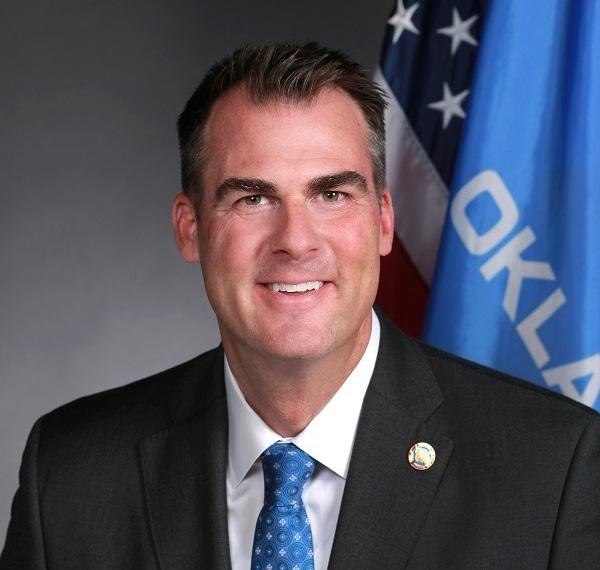
Incumbent, Republican gubernatorial candidate
• Aims to increase teacher wages to six figures
• Supports school vouchers and open-transfer laws
• Supports House Bill 1775
• Wants additional financial audits of the State Department of Education

Joy Hofmeister (D)
Oklahoma superintendent of public in struction, Democrat gubernatorial candi date
• Does not support school vouchers and school choice
• Does not support House Bill 1775
• Aims to increase number of counselors in schools
• Aims to increase mental health and substance abuse resources in schools
• Aims to make teacher pay more com petitive
• Aims to increase number of support staff
Ryan Walters (R)

Stitt-appointed Oklahoma secretary of education, Republican superintendent candidate
• Supports school vouchers
• Supports House Bill 1775
• Supports emergency certifications for school openings
• Aims to increase teacher wages to six figures
• Does not support federal education funding
Everything is decided by someone who’s elected. So every election, every one of them — from the school board race to a state House race — every one of them, education is on the ballot.”
Stitt signed House Bill 1775 into law in May 2021, prohibiting public schools from teaching that a person, because of their race or sex, is inherent ly racist, sexist or oppressive, either knowingly or unknowingly. Currently, the OU Black Emergency Response Team, American Association of University Professors and American Civil Liberties Union of Oklahoma are challenging the state law, saying the bill suppresses their right to talk about race and gender issues and prevents discussions of a complete U.S. history.
The bill led to several conversations surround ing race and gender in public education, with ed ucators saying the language of the bill is vague and up for interpretation. This led to conflicting deci sions and targeted attacks on teachers, school dis tricts and certain curricula, Bishop said.
Over the summer, the Oklahoma State Board of Education voted 4-2 to downgrade Tulsa Public Schools’ and Mustang Public Schools’ accredita tion status after the districts were found to have violated HB 1775 during implicit bias training for teacher.

The State Department of Education only rec ommended the downgrade be to “accredited with a deficiency,” but the board, made up of Stitt’s ap pointees, took it a step further by downgrading the school districts to “accredited with warning.”
In 2021, Hofmeister said she believed the bill should not have been rushed through by legisla tors before consulting educators.
She voted against the accreditation downgrade for Tulsa and Mustang. Walters advocated against Hofmeister during the state board’s meeting, say ing she failed the children of Oklahoma by allow ing pornography in schools.
Several Oklahoma school districts removed books by minority and female authors, including Lorraine Hansberry’s “A Raisin in the Sun,” Maya Angelou’s “I Know Why the Caged Bird Sings” and Harper Lee’s “To Kill a Mockingbird,” to avoid downgrades or complaints.
Jena Nelson (D)
Classen SAS Middle School teacher, Demo crat superintendent candidate
• Aims to increase funding for public and rural schools
• Does not support school vouchers
• Aims to increase teacher wages
• Aims to increase number of mental health counselors in schools
• Does not support House Bill 1775
Megan Lambert, the legal director of the American Civil Liberties Union of Oklahoma, de scribed the bill as being so vague that educators don’t and can’t be expected to understand what is being restricted and the consequences for vio lating the law. Because school districts are leaving it up to the teachers to abide by the law, she said many are “playing it safe.”
“When students, especially those who are not heterosexual or white, see only that (white, heter onormative curriculum) is in their schooling, that results in students feeling othered and separated and overlooked,” Lambert said. “Lessons are bare bone or nonexistent.”
Doyle-Lackey said, because Oklahoma is a conservative state, the bill was not a surprise, but the vagueness of the bill was. According to the Pew Research Center, 60 percent of Republicans in Oklahoma reported to be conservative and 18 percent of Democrats reported being conserva tive. The State Election Board says 50.1 percent of Oklahoma voters are registered Republican and
13
*Information gathered from candidates’ campaign sites and news articles
32.9 percent are Democrats.
Summer Boismier, a former Norman High School teacher, resigned over the summer when a parent complained that, by displaying a QR code to Brooklyn Library Books Unbanned in her class room, she violated the state law. Walters called for the state board to revoke Boismier’s teaching cer tification, saying he was speaking for all parents and children in the state of Oklahoma.
“There is no place for a teacher with a liberal political agenda in the classroom,” Walters said. “Ms. Boismier’s providing access to banned and pornographic material to students is unaccept able and we must ensure she doesn’t go to anoth er district and do the same thing.”
In response to Walters’ request to revoke Boismier’s license, Nelson said HB 1775 frightens teachers, as the law is too “ambiguous.”
Doyle-Lackey said her peers are worried about being unable to accurately teach topics of race and bias if politicians who support the bill remain in office.
Lambert did not explicitly say which candidates are conflating these issues, but she did say the issue is statewide and isn’t slowing down.
Lambert and Doyle-Lackey said race and gen der curriculum is one of the leading issues for public schools as the general election approach es. The way Stitt and Walters govern classrooms will be “detrimental” to social studies and English education in the state, they said.
“There’s a lot more to teaching than just
teaching to the test,” Doyle-Lackey said. “We have all these outside legislators controlling what we can teach, but (these laws) don’t address anything that actually happens in schools.”
Doyle-Lackey said HB 1775 is harmful for edu cators, as it prevents all voices and students from being represented in Oklahoma classrooms and curriculum.
“(The bill is) a way to promote Eurocentric edu cation and white supremacy, which does suppress students of ethnic minorities,” Doyle-Lackey said. “It also further suppresses students who identify with different gender identities or have different sexual orientations. We’re not really adjusting (to) the dynamic society of students and how they’re changing, and we’re not meeting their needs.”
Bishop said, in conversations with other educa tors, that the topic of school vouchers is swaying the votes of teachers.
Walters and Stitt, among other state legisla tors, tout school choice. They argue that vouch ers allow parents to make the best decision pos sible for their kids by letting them attend private schools or be homeschooled over public schools.
Vouchers help pay part of a student’s private tuition using taxes that would normally be allo cated toward public schools. Private and charter schools, however, are not responsible for provid ing free transportation, meals or supplies, Bishop said.
Stitt described vouchers as “scholarships” for students during a discussion on education with
the Leadership and Policy Center for Thriving Schools and Communities at OU. He said vouch ers help students get out of public schools with poor records and low test scores, instead of fund ing the school.
Stitt said the schools would not be fixed from within during the discussion at OU. He said his goal is to allow individual students to leave public schools with high dropout rates or low test scores.
Nelson disagrees, stating it is more important to fund public schools, according to her campaign website and in debates. Hofmeister also disagrees with Stitt and Walters on school vouchers, calling them a “rural school killer.”
Bishop said although the concept seems ben eficial on the surface, she believes they are det rimental to education in Oklahoma. She said vouchers would likely go to students enrolled and paying tuition at private schools before being of fered to children at public schools.
Around 90 percent of Oklahoma children at tend public schools, according to the Oklahoma Education Coalition, or the OEC, and the Oklahoma Parent Legislative Action Committee. Both the OEC and Oklahoma State School Boards Association oppose vouchers, saying they take money away from public schools and that the state already has transfer laws allowing students to attend schools in other districts.
“Anytime that you take public dollars and start putting them to a private entity, you will start eroding that public entity,” Bishop said. “Even
 KAROLINE LEONARD/OU DAILY
KAROLINE LEONARD/OU DAILY
14
In a discussion at OU, Gov. Kevin Stitt touted school choice and vouchers as a way for students to leave public schools and attend private schools with reallocated tax dollars.
if one student goes to a private school and takes a voucher with them, there are still 19 other kids in that (public school) classroom. There’s still a teacher in that classroom. There are still all the ex penses that are required to be paid. So it is a way to dismantle our public schools.”
In September, the State Department of Education released new data on test scores, show ing how some scores have improved amid the pandemic.
The Oklahoma State Department of Education reported that the number of students who scored at their grade level increased for each age and sub ject area with two exceptions.
In 2022, about 2.6 percent fewer eighth grad ers showed mastery of science in their grade level compared to 2019. Fewer high school juniors were proficient in math, with only a quarter of all Oklahoma students scoring at grade level in math.
The results indicate the majority of Oklahoma students scored at a basic or below basic level. Below basic, according to the State Education Department’s report, means students are not on track for college or career success.
Bishop said people need to look at test scores holistically. Overall, she said the state is doing better than it has in years past, but issues like the teacher shortage, teacher pay, low resourc es and money spent per student all contribute to these test scores and the education of Oklahoma children.
In the 2020-21 school year, Oklahoma Public Schools ranked 45th in the nation for per-stu dent spending of about $10,553. Education sup port professionals in the state made an average of $28,246, ranking last in the U.S.
Oklahoma ranked 39th in the nation for its av erage starting teacher pay of $38,074. The state is 34th in its average teacher salary, which is $54,762.
During the discussion with OU THRIVE, Stitt said Oklahoma teacher pay has been increasing and the state is “ahead of the game” compared to the rest of the country.
“Teachers normally don’t get into this profes sion to get rich,” Stitt said in the discussion. “They get into this profession because they have a heart for young people.”
Stitt also explained that his administration was preparing to pay teachers six figures. Stitt claimed the state was the top in the country for teacher pay, state test scores and per-student spending.
“I don’t know where the governor got his figures from, but we are (at) the bottom,” Bishop said.
Bishop and Doyle-Lackey said the teacher shortage is exacerbated by Oklahoma not having competitive pay for teachers. Doyle-Lackey said teachers “wear a lot of hats,” and they often have to pay out of pocket for school supplies, classroom necessities and more.
Bishop said part of the reason test scores are improving is that, after the pandemic, federal re lief money was given to education, leading to in creased scores.
“We’ve made improvements, and I think we’ve lost sight of that,” Bishop said. “There’s a lot of money that came into every state, especially our state, with federal relief dollars to help make up for any disruptions that happened during the
Federal relief money distributed
ized test scores. Educators believe this indicates a need for increased public education
pandemic. We’ve shown that our students have made up and gained on their test scores, so there is the example that putting more money into (ed ucation) does help. Our test scores showed that.”
Walters pledged that, if elected, he will stop fed eral funding from entering Oklahoma to prevent federal oversight in public schools. Doyle-Lackey and Bishop said this federal funding creates eq uity, creates jobs, pays the bills and is the support every student and teacher needs.
“(Cutting federal funding) will have a tremen dous impact on education. Many of our salaries are paid through federal funding. Federal funding was created to bridge that gap and provide equi ty,” Bishop said. “It provides services for our stu dents with disabilities, our students that are eco nomically disadvantaged and to make sure that our students who are English learners or Native American … have an equitable funding source.”
In comparison, Nelson supports increasing and requesting more federal funding. Nelson ex pressed her support for Hofmeister’s annual edu cation budget request in September, which would include a $5,000 pay raise for teachers.
“From day one of my campaign, I have been clear that providing the pay, resources and sup port Oklahoma teachers need is critical to pre venting teacher flight and expanding the amount of quality educators and support staff includ ing paraprofessionals,” Nelson wrote in a press release.
Aiyana Henry, the associate dean for profes sional education at OU Jeannine Rainbolt College of Education, said teachers are vital for students’ careers and futures. She said despite the contro versy and turmoil education has experienced in the state, it is an exciting time to be a teacher.
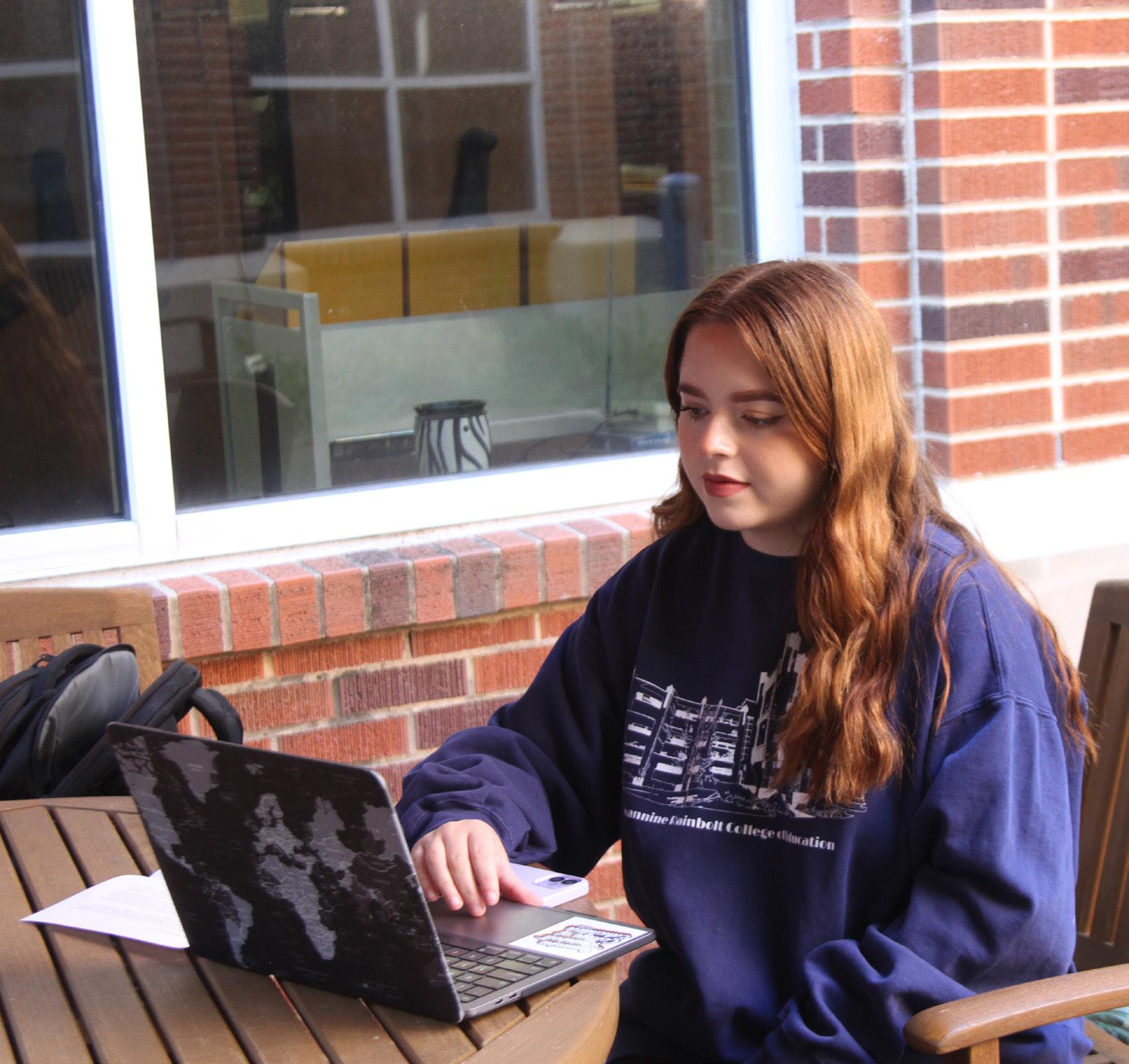
“If you think about it, in all professions, any thing that we’ve done, we were inspired by a teacher,” Henry said. “There was a teacher that helped create a pathway for us to be where we are.”
Bishop and Doyle-Lackey said getting out to vote in November is the most important thing. They both explained that voting with education at the forefront of the mind is the only way to im prove the state as a whole.
Doyle-Lackey said she still dreams of being an educator. She hopes to inspire students and teach history that is accurate, transparent and all-en compassing. She said the only way she can do that is if Oklahomans vote for education.
“It’s crucial for the public, not just aspiring edu cators or current teachers, to recognize the impact that public education has on students and teach ers,” Doyle-Lackey said. “Education, at its basic roots, can help people overcome economic in equality and social inequalities. Oftentimes, I feel like teachers and students just get left out when people go to the polls, but I feel like this time, more than ever, it’s important for people to recognize the importance of our field.”
KAROLINE LEONARD/OU DAILY
15
to schools during the COVID-19 pandemic was accompanied by higher standard
budgets overall.

Competing against professionals across the state, the OU Daily earned 19 top honors awarded by the Oklahoma Society of Professional Journalists. Honors included: Online multimedia /podcast Newspaper government reporting Newspaper in-depth enterprise and investigative reporting Best newspaper Best website, OUDAILY.COM #1 #2 #3 YOUR SOURCE FOR TOP-RANKED JOURNALISM Winner of 2022 Carter Bradley First Amendment Award For work that aimed to reset norms around transparancy at OU and in Norman
Soniyes revitalizes 15-year legacy
former OU student. In 2007, OU freshman Nizami wanted to start a dance organization at OU since she always watched university Bollywood-fusion dance team performances on YouTube.
 ANUSHA FATHEPURE anusha.fathepure@ou.edu
ANUSHA FATHEPURE anusha.fathepure@ou.edu
The dancers snapped their arms in sync as the beat dropped, smoothly switching between dance formations. They moved from hip-hop to bhangra to South Indian dance with ease, confidence and flair, mixing Western dance with various Indian and Bollywood styles.
The team performs with passion, carrying on a 15-year legacy that began with Nida Nizami, a
Nizami had danced her whole life and she wanted to continue at OU. She felt dance would help her showcase the culture of OU’s South Asian population and give past dancers the platform to continue their cultural art into college. Nizami reached out to junior Divya Byragani, who had previously attended Virginia Tech and had prior experience with the university’s dance team.
“It was really haphazard, honestly,” Nizami said. “We went in pretty blindly.”
Starting a dance team from scratch, Nizami and Byragani ran into difficulties. Social media did exist at the time, but there weren’t many online re sources to contact or see what other organizations were doing. They built their team, Soniyes, from
their own knowledge and trial and error.
Soniyes went in and out of hiatus for the next couple of years until 2021, when Sianna Raja re vived the dance team during her junior year at OU. Raja, like Nizami, grew up dancing and par ticipated in her dance team at Alma High School in Alma, Arkansas.
One of the reasons Raja chose OU was because of the Bollywood-fusion dance group. She hoped to join Soniyes at the beginning of her freshman year, but the team was never put together because of a lack of interest from students coupled with the COVID-19 pandemic.
As Raja entered her junior year, students be came more interested in the team. With the num ber of freshman girls interested, she could revive Soniyes.
Raja decided to try out for team captain. She and two other girls sent audition tapes to the
17 Bollywood-fusion dance group offers safe space for cultural expression for South Asian students at OU
Soniyes dancer Khushi Patel rehearses on Oct. 19 in Adams Hall. The team rehearses from 10 p.m. to midnight every Sunday, Tuesday and Thursday.
RAY BAHNER/OU DAILY
former dance captain, Purvi Patel, and Raja was selected. She worked closely with Patel in rebuild ing the team.
“It was a big learning curve,” Raja said. “I didn’t have a lot of information on how things were sup posed to go, so it was kind of like (figuring) it out as I go … to the best of my abilities.”
Raja used social media and connections through OU’s South Asian Student Association to get the word out. Raja created a one-minute rou tine and a judging rubric and held auditions in the Sarkeys Fitness Center.
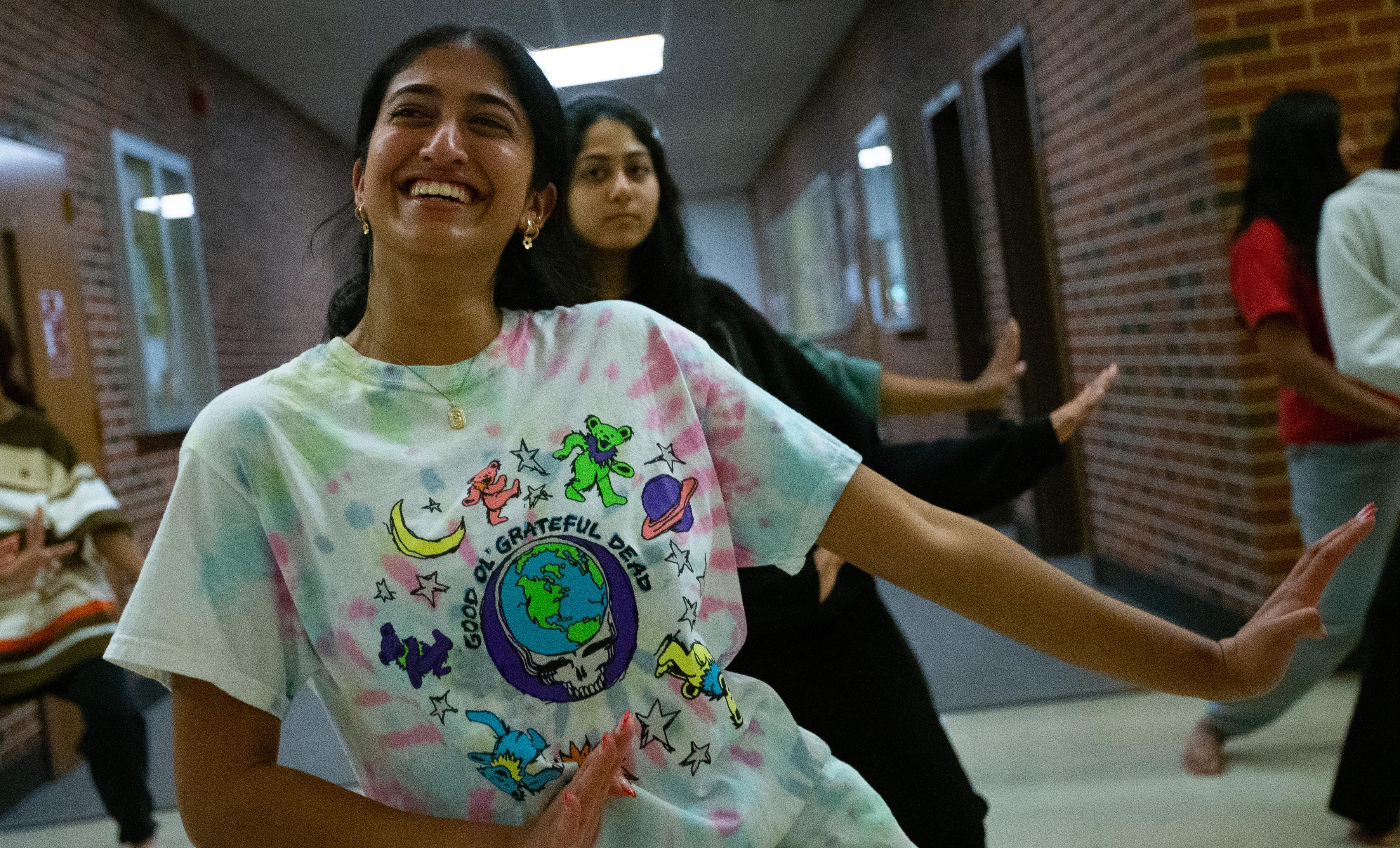
“The biggest thing when I was judging the trials was (determining): How coachable are they, and do I think that I can work with them and get them to be very in-sync and (coordinated) with each other?” Raja said.
She emphasized the hard work and effort of the whole team in restarting Soniyes. Raja would often consult other team members for sugges tions and ideas and make decisions as a collective group.
“I don’t want to say I’m the reason it’s back, be cause I think everyone (was involved),” Raja said. “It was like a ticking time bomb just waiting for enough people to want to do it.”
Fifteen years after its original formation, the 2022-23 Soniyes executive team succeeded in making the group an official OU-affiliated organi zation with the help of their faculty adviser, A.K. Fazlur Rahman, a chemistry professor.
For Nizami, seeing Soniyes finally become an
OU-affiliated organization, an aspiration she had for the team after graduating, means a lot.
“Dance is liberation,” Nizami said. “It’s such a freeing thing, especially during the grind (of) col lege. … (Soniyes was) an amazing creative outlet for me. … It’s a special feeling for sure to see the
nowadays, and I think that’s because people are ignorant of what’s going on. Sometimes people just don’t know more about different cultures … and it’s our job to teach them. … You have to have that initiative and drive to share that with other people.”
Senior captain Ciara Patel hopes OU will con tinue to support and uplift culturally diverse or ganizations like Soniyes. She emphasized the struggles of getting funding and public interest as a South Asian dance team in comparison to the larger, noncultural dance teams on campus.
She feels that OU’s official recognition of the team is a big step toward bringing awareness to and highlighting diversity on OU’s campus. She said the dance team is on a path to becoming more developed and established.
Soniyes’ status as an official organization has also helped some members find community and camaraderie in the team.
“The importance of groups like Soniyes is to create a safe community where people can feel welcome,” said Nitya Arekatla, a former Soniyes dancer and current marketing manager.
things you created grow into what you hoped for it.”
Now that Soniyes is an official organization, Raja said it can better inform the OU community about South Asian culture.
“It’s so much easier when you’re official to get the news out there … about what we are and what we do,” Raja said. “Our world is very divided
Arekatla described growing up in Lawton, Oklahoma, and not having access to South Asian dance classes near her. She said the closest she got to a real dance class was when her moth er encouraged her to learn choreography from YouTube videos.
Soniyes was the first time Arekatla had the opportunity to perform Indian dance
18
I think dance is just an easy way to connect with your culture and others. ... (Soniyes) is like a family.
NITYA AREKATLA, former Soniyes dancer and current marketing manger
“ “
RAY BAHNER/OU DAILY
Junior Soniyes captain Simi Kurella rehearses with dancers on Oct. 19 in Adams Hall. Kurella joined the team in 2021 and took on a larger leadership role.
organizationally. For Arekatla, dance was an ac cessible way to connect with her Indian heritage.
“In America, (it’s hard) to get the food that you’re used to, the cultural things that you do, (compared to when) you’re back home,” Arekatla said. “I think dance is just an easy way to connect with your culture and others. … (Soniyes) is like a family.”
For junior captain Simi Kurella, dance has been a means of self-expression. Kurella learned about Indian classical dance since she was a child, and the dance team has allowed her to continue this passion into college.
Kurella believes Soniyes provides a way for dancers to demonstrate their American and Desi backgrounds while staying in touch with their cul ture. One of her main goals as junior captain this year is to create a close and friendly environment for the entire team.
First-year dancer Chandini Kanderi has danced bharatnatyam, a form of Indian classical dance, since she was 4 years old. Throughout her time as a dancer, she has learned Bollywood, bharat natyam, bhangra and hip-hop.
Dance has always been something Kanderi hoped to pursue in college, and she was happy to learn that the team had been restarted last year. She learned of Soniyes from childhood friend Pragathi Gowda, the junior captain of Soniyes.
Soniyes has been both a creative outlet as well as a welcoming and friendly community for Kanderi in her first year of college. She said she
feels Soniyes has been a great way for her to meet others with similar interests as her.
“I really love the other girls,” said Kanderi. “We’ve already gotten close, and I look forward to Sunday (dance practice) because it’s just so fun to be together.”
The Soniyes executive team is very passionate about their leadership roles and are working to create a strong dance team that can have a lasting legacy, Patel said.
“I really hope there is not another hiatus,” Raja said. “Even if it seems there are not enough girls to compete, I hope there’s still an organization on campus that’s still performing. … I don’t ever want (Soniyes) to disappear.”
Kurella joined last year and is now serving as a junior captain of Soniyes. She loved the team environment during her first year and wanted to take on a larger leadership role. She works togeth er with Gowda and Patel to choreograph, create mixes, raise funds and set formations.
“Even though it’s a time-consuming position that takes a high level of commitment, I love being a captain,” Kurella said.
While the dance team did perform at compe titions in Dallas, Soniyes’ performances during Nizami and Byragani’s time were centered around OU’s India Nite, a cultural event where OU stu dents enjoyed dance, music and Indian cuisine. Nizami said at the event she saw some people dance with their friends but wanted her own team to be a professional dance group.
Now, Soniyes aims to compete on a larger scale among other dance teams all over the nation.
Desi Dance Network is a national organization aimed at preserving South Asian artistic traditions and combating cultural erasure. The organization co-hosts and sponsors various events across the nation. Soniyes hopes to compete at the network’s national fusion dance circuit in the spring.
“It’s a big goal of ours to compete this year,” Kurella said. “I’m quite confident we can achieve this goal, but it’ll take a lot of hard work and ded ication, not only from the captains, but also from the entire team.
Soniyes holds practices every Sunday, Tuesday and Thursday night, and the team is currently preparing to film their audition tape to submit to the network. The dancers have been practicing a routine including hip-hop, bhangra, Bollywood, bharatanatyam and South Indian-style dance.
Soniyes is also working to reach wider audienc es and usher in a generation of more diversified dancers on OU’s campus. Patel’s primary goal this year as senior captain is to make Soniyes more inclusive.
“Soniyes is open to anybody,” Patel said. “I can’t emphasize that enough. You don’t have to be Indian. You don’t have to be a girl. You don’t have to be an undergraduate. … Anybody is welcome to join, even if you don’t have dance experience. You just have to be willing to learn.”

19
RAY BAHNER/OU DAILY Soniyes dancers rehearse in Adams Hall on Oct. 19 in Adams Hall. The team is preparing to submit an audition tape to the Desi Dance Network.
SCAN ME




 The Red Cup by the OUSWPC and paid for by SAMHSA SPF-PFS. Q&A is written
The Red Cup by the OUSWPC and paid for by SAMHSA SPF-PFS. Q&A is written
Section 8’s ‘broken system’
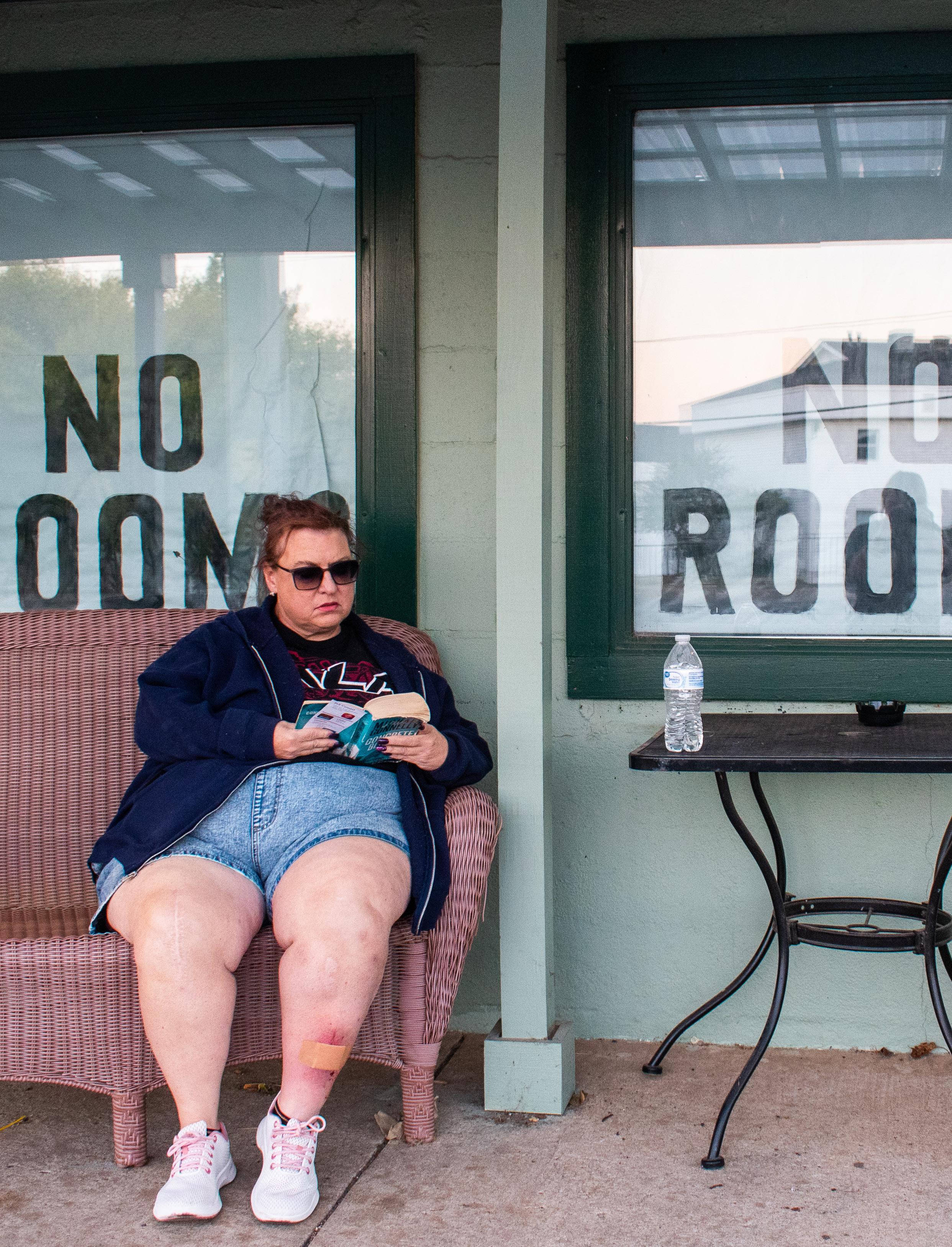
KYLE/OU DAILY
REGHAN
Unhoused Normanites are frustrated with a complex housing voucher application process, detailing systemic failures in city resources
PEGGY DODD/PLAIL@OU.EDU 21
Becky Tyler was a stay-at-home mom.
AlfredoTandarnespentgamedaysinNorman asacustodianintheSooners’stadium.
WalisaSanderswasretired.
Tyler, Tandarne and Sanders now experience homelessness and are in need of help as they seekhousing.
SanderssaidthatpeoplewithSection8vouch ers, an assistance program that provides rental subsidies, are left to find a home with little help. The voucher grants 120 days to find a property, allowing for two 30-day extensions. Normanites have to restart the process if they fail to secure housingbeforetheexpirationoftheirextensions.
Lisa Krieg, manager of the community de velopment block grants program for Norman, estimates a shortage of 9,000 rental units that shouldrangeinaffordability,basedonAmerican CommunitySurveydata.
There isn’t an exact number of affordable housing units currently available in Norman, as affordability is dependent on the tenant’s in come,Kriegwroteinanemail.
There are multiple assisted units in Norman that are either tax credit properties or housing that is developed with a specific funding source thatmaintainsaffordability.Thisincludespublic housing and properties aimed at specific popu lations,liketheelderlyorpeoplewithdisabilities.
Section 8 housing vouchers aid people in sit uations similar to Tyler, Tandarne and Sanders,’ but obtaining a voucher isn’t easy. Applications are only accepted in paper form and require threetypesofidentificationbeforepeoplecanbe placedonawaitlist.SandersandTylersaiditwas alonelyone.
Sanders said she didn’t feel supported in a “broken system,” and both women highlighted thedifficultiesthatcomewithobtainingavouch er. Sanders said the process was too robotic and shefeltshewasbeingsetupforfailure.
According to the U.S. Department of Housing and Urban Development, public housing agen cies control voucher programs locally, with case managersprovidinghousingassistance.Theau thority covers most of the costs, and the tenant paysaportionoftheirrentbasedonincome.
“(Housing Authority employees) don’t make you feel supported,” Sanders said. “They don’t make you feel welcomed, and they (don’t show they) want to help you or that they care. And if you need help, the hell with calling somebody that has your case. … They’ll say: ‘We can’t help you.’”
Tyler has experienced homelessness for over four years, and her housing search has been lengthenedbyabraintumordiagnosis,badrent alhistoryanddivorce.Anexpireddriver’slicense and no birth certificate also prevented her from completingherpaperworktoapplyforSection8.
Tyler eventually received a voucher that will expire at the end of November and is temporar ily staying at the OU Motel. While she’s hopeful she’ll find a more permanent residence before then,Tylerisunsureofwhetherthatvoucherwill berenewed.
Tyler has checked her email for two weeks for an update about her application for an
apartment on Alameda Street. Without any up dates as of Oct. 30, she said employees at Food and Shelter helped her find available properties, as they have their own case managers and oper ate both rehousing and permanent supportive housing programs.
Tyler was a single mother of three after her divorce. Her children are older now, and her 25-year-old daughter, who is also a mother, works in Tulsa. Her 21-year-old daughter lives in Norman and vowed to help Tyler get back on her feet. Her 20-year-old son is a graduate of the Bridges of Norman Program, which assists teen agers experiencing homelessness with graduat ing high school.
“I’m just frustrated by the whole thing,” Tyler said. “Frustrated with myself for getting into this mess and for staying (in) this mess for so long. My kids shouldn’t feel like they need to take care of their mom.”
Tandarne experienced a fate similar to the estimated 9.6 million Americans who lost their jobs due to the COVID-19 pandemic. He was let
Affordable housing has faced complications from the council, as plans to renovate a former specialty hospital into housing units were origi nally shot down at the Aug. 9 meeting in a 4-to-3 vote. The project was one vote short of passing, with two members absent and the three self-pro claimed conservatives, including Mayor Larry Heikkila, Ward 3 Councilmember Kelly Lynn and Ward 5 Councilmember Rarchar Tortorello, vot ing against the measure.
The project was later revisited on Aug. 22, passing with a 5-to-3 vote. Heikkila, Lynn and Tortorello voted against the measure again. Ultimately, the specialty hospital’s budgetary needs grew too large for the city.
City staff is exploring a new property: a former hotel located at 309 Norman Center Ct.
In 2021, the city of Norman, in partnership with the Cleveland County Continuum of Care, released a HomeBase gaps analysis based on community feedback and the opinions of peo ple experiencing homelessness between January and June.
Over 85 percent of respondents agreed or strongly agreed that it is possible to reduce the population of unhoused people in Cleveland County significantly.
The study identified seven key areas where municipalities could support people experienc ing housing insecurity, including opportunities for safe and affordable housing, support services and prevention assistance.
Cleveland County has just under 300,000 residents, according to the U.S. Census Bureau, making it the third-most-populous county in Oklahoma. The HomeBase study estimated that nearly one-third of the county’s overall popula tion is in danger of becoming homeless because of cost burdens, which is when 30 to 50 percent of a household’s income is allocated toward hous ing expenses.
go from OU after two years working as a stadium custodian and now relies on a bicycle to search for housing.
Tandarne said he’s ready to get back to work after being unhoused for over two years. He’s on his third Section 8 voucher but has struggled to find a property. Tandarne said finding a home is the first step in recovering from the lasting effects of the pandemic.
The effects of COVID-19 on affordable housing have been top of mind for Ward 1 Councilmember Brandi Studley following the end of moratoriums on evictions. In September 2020, the Centers for Disease Control halted evic tions to prevent the spread of COVID-19 and pro vide aid to individuals who couldn’t work during the pandemic.
“We’ve been really concerned and (are) trying to keep our eye on the aftereffects of COVID-19 and what that looks like for families who were not having to pay rent and now are,” Studley said.
The future of affordable housing in Norman is partially in the hands of city council members in consultation with organizations like Food and Shelter. The council placed affordable housing as one of its priorities for several years in a row, including at its yearly retreat this past summer.
A team of OU researchers is working on a gaps and needs analysis of homelessness services across the state. The team includes Christina Miller and David McLeod, both OU social work professors, Bryce Lowery, a regional and city planning professor, and eight graduate students.
Their data is collected from focus groups with service providers and people facing housing in security or who are currently unhoused.
Lowery said the federal government is posi tioned to give about $32 million to Oklahoma to prevent homelessness and aid unhoused people. The purpose of the research project is to create a plan to give to the Oklahoma Housing Finance Agency that will determine program allocations.
Lowery said though it wasn’t the system’s in tention to become so difficult, the team under stands Section 8 is “really problematic.”
“Something we’re finding is that the voucher system is almost like a scarlet letter on people, in a weird way,” Lowery said. “It’s not meant to be that way, but many landlords now would rath er find non-Section 8 people to rent to because of the paperwork and the bureaucracy that’s involved.”
McLeod said out-of-state investors and cor porations purchasing housing property in
22
They need to change their system. They need to change from the way they used to do things years ago.
WALISA SANDERS, Norman resident
“ “
Oklahoma and raising rent makes them ex tremely hard to communicate with while searching for housing.
“We were able to advocate for people to get into housing, and a lot of those tools that service providers had before, they don’t have anymore because those relationships have been dimin ished,” McLeod said.
McLeod said an absence of local landlords has fueled Norman’s affordable housing prob lem, as out-of-state landlords are less likely to accept any housing vouchers.
A voucher often comes with stipulations for the landlord that a housing unit must be kept to a certain standard of living, McLeod said. He said landlords can make more money on subpar conditions, as vouchers only pay the market rate for properties.
Lowery said OU threatens housing options with an undergraduate student population of over 26,000 and over 11,000 faculty and staff, according to the OU Fact Book. He said the stu dent and faculty influx and the number of visi tors drawn to the school affect the city’s real es tate market.

Emily Johnson, a social work master’s stu dent, said most housing in Norman under $500600 a month is reserved for students. During the early days of her housing search, Tyler recalled that her daughter found a property for $500 a month that she could afford but was disappoint ed to discover it was student housing.
McLeod said Norman is already one step ahead in improving housing conditions by being willing to address the situation. Johnson said shifting community attitudes regarding homelessness and abandoning stereotypes about the unhoused population was important to support affordable housing efforts.
“(Unhoused people are) going to be in our backyard,” Johnson said. “They’re going to be our neighbors. Disbanding the myth that home less people struggle with mental health issues or that homeless people are dangerous, in addition to affordable housing, would be the two most prominent things.”
Tyler wants a safe place to stay at night where she can leave her belongings during the day while searching for housing or work opportunities.
Tandarne utilizes the Food and Shelter lunch service but tries to not lean too much on service providers while searching for housing.
Sanders said she hopes to see fundamen tal changes in the Section 8 system to ensure vouchers are cashed and housing is obtained.
“They need to change their system,” Sanders said. “They need to change from the way they used to do things years ago. They’re not real ly acting like they want to help people. … I will speak my mind when I feel like I’m being mis treated, disrespected, locked down and frowned upon because I’m in the situation I’m in.”
23
REGHAN KYLE/OU DAILY
The COVID-19 pandemic and existing difficulties in the Section 8 application process are making it increasingly difficult for unhoused people in Norman to find permanent housing options.
















 KAROLINE LEONARD karolineleonard@ou.edu
KAROLINE LEONARD karolineleonard@ou.edu




 KAROLINE LEONARD/OU DAILY
KAROLINE LEONARD/OU DAILY


 ANUSHA FATHEPURE anusha.fathepure@ou.edu
ANUSHA FATHEPURE anusha.fathepure@ou.edu






 The Red Cup by the OUSWPC and paid for by SAMHSA SPF-PFS. Q&A is written
The Red Cup by the OUSWPC and paid for by SAMHSA SPF-PFS. Q&A is written



